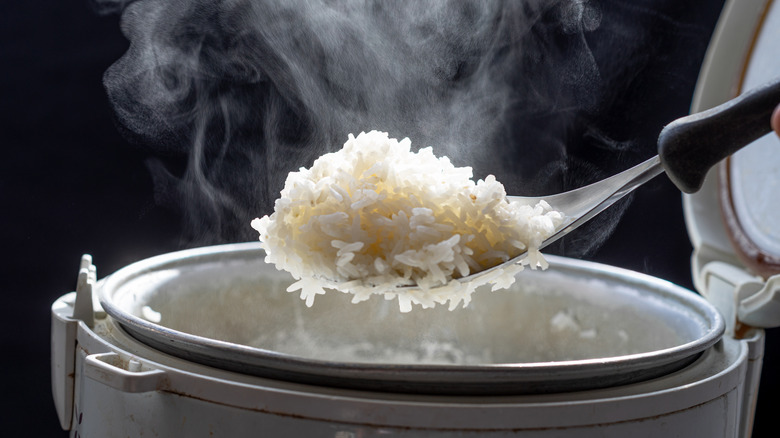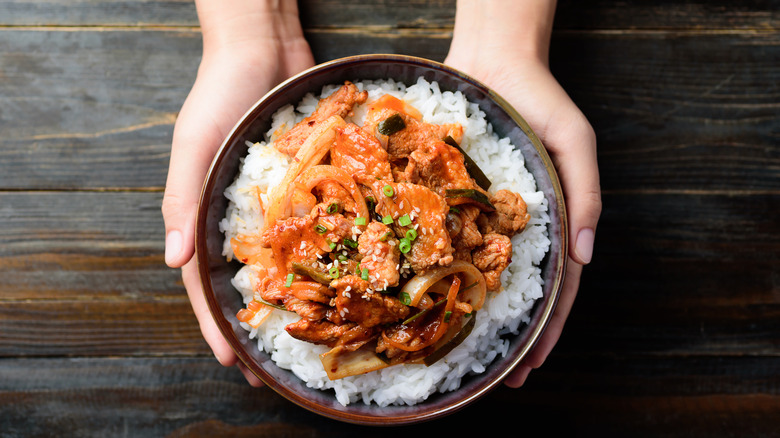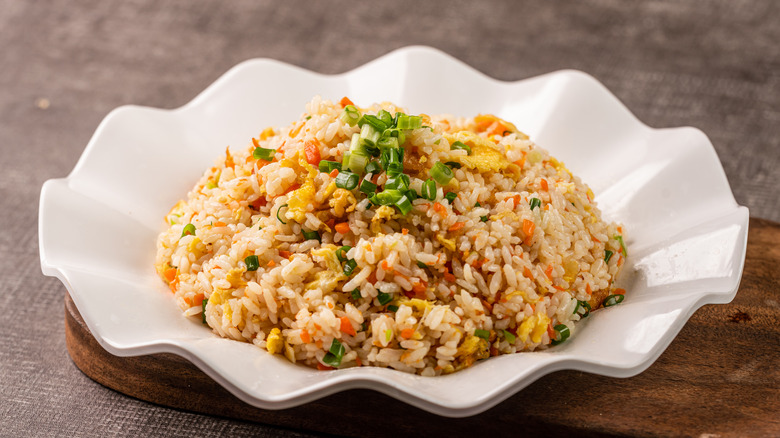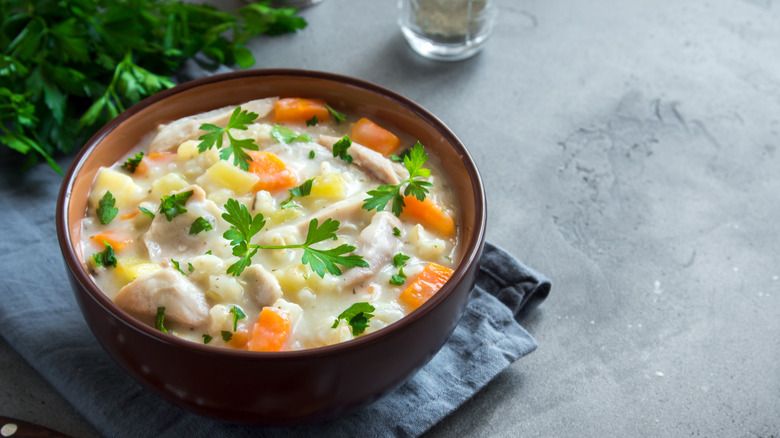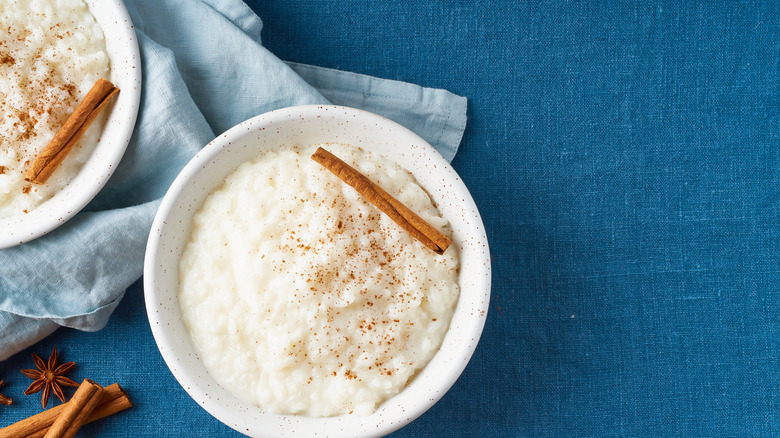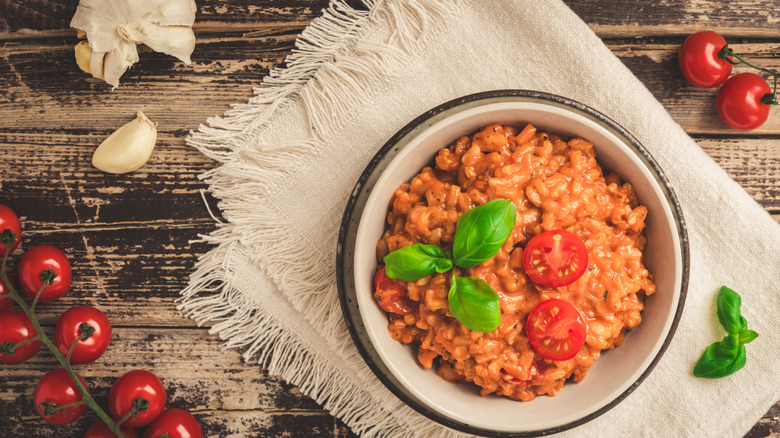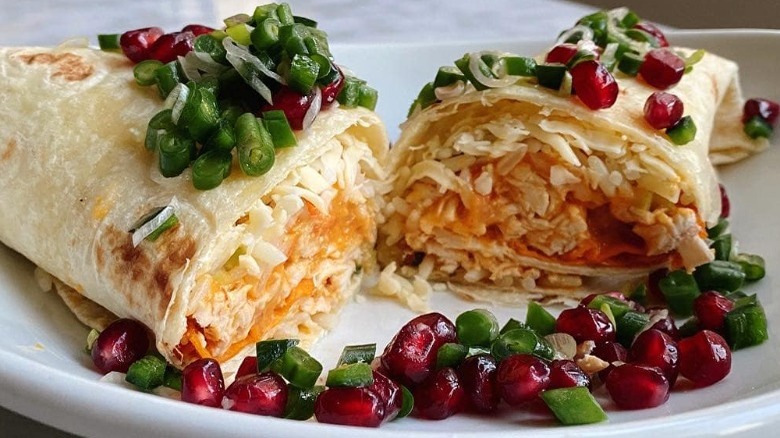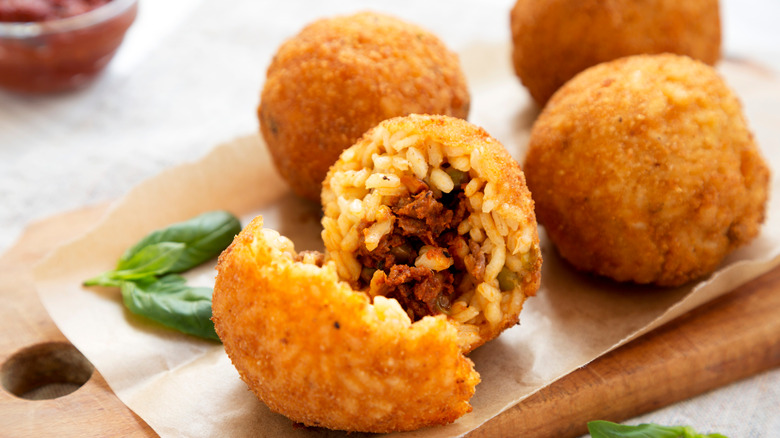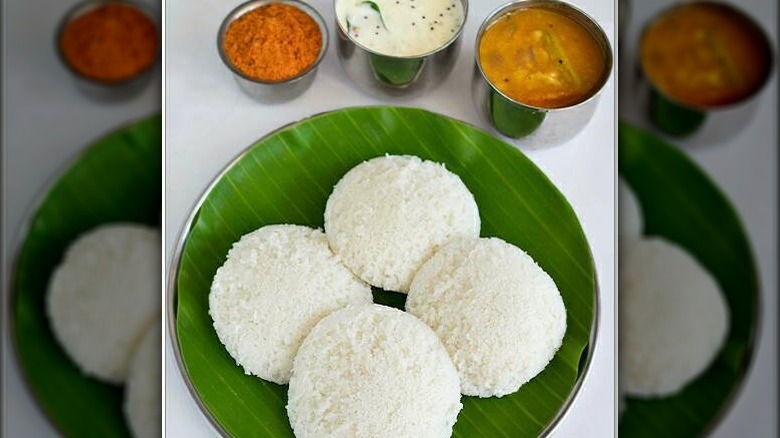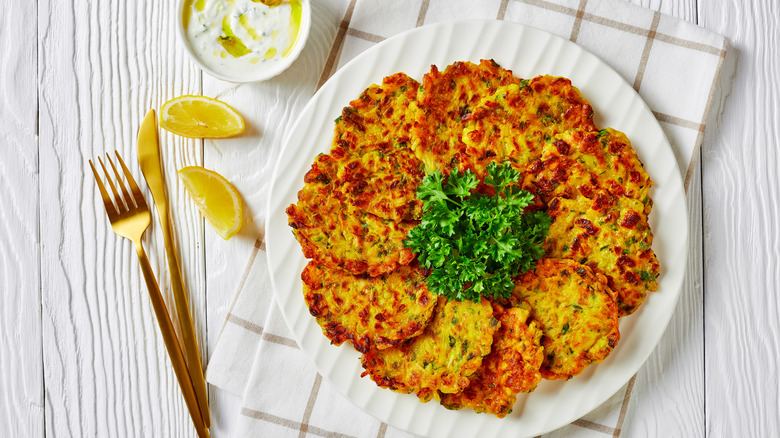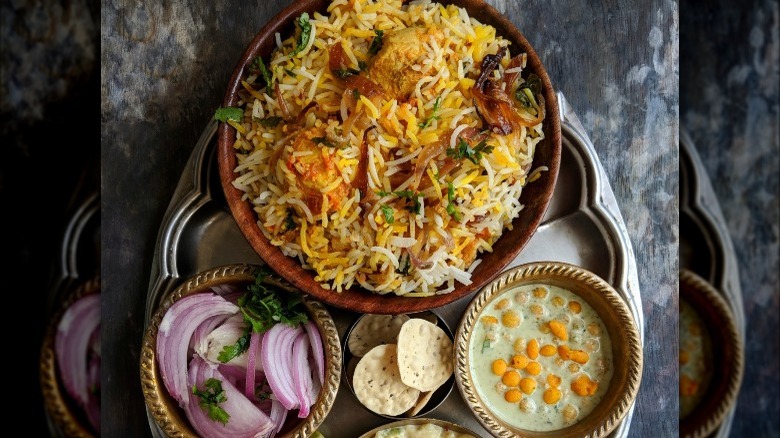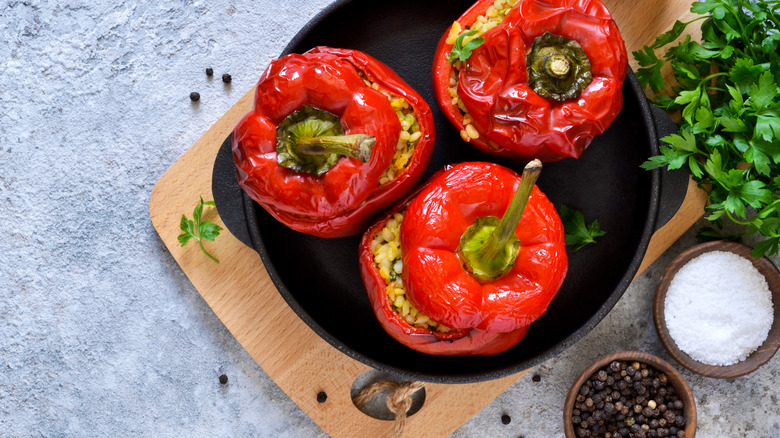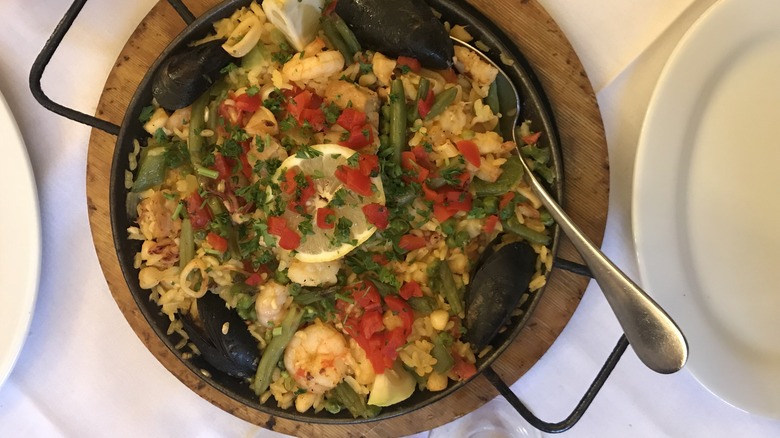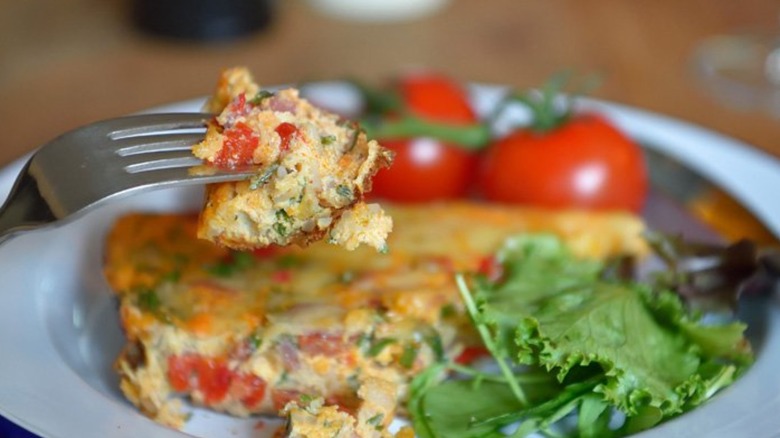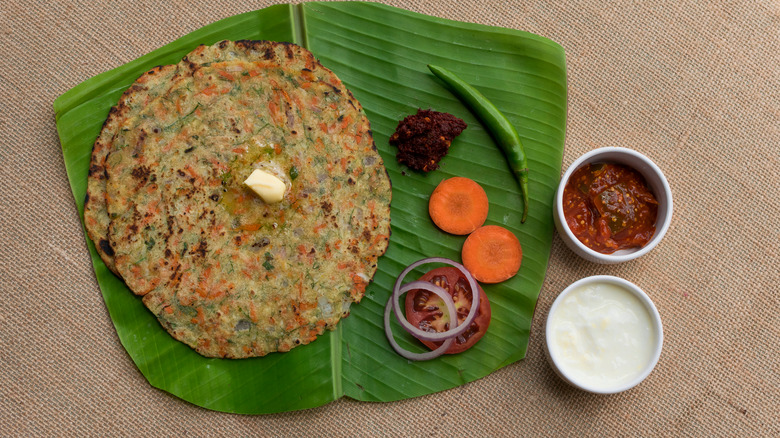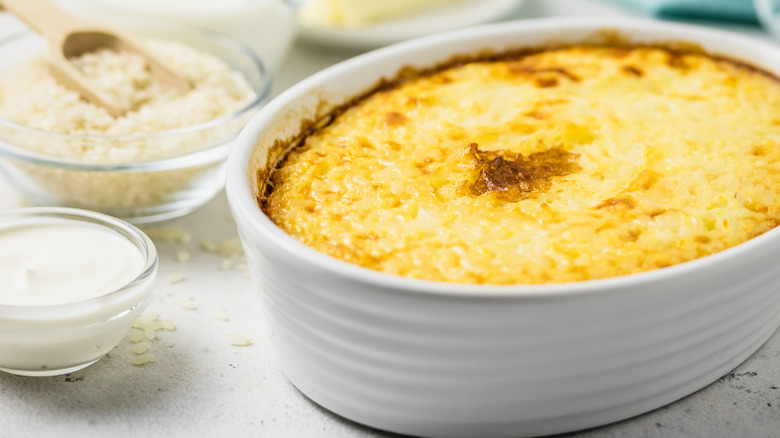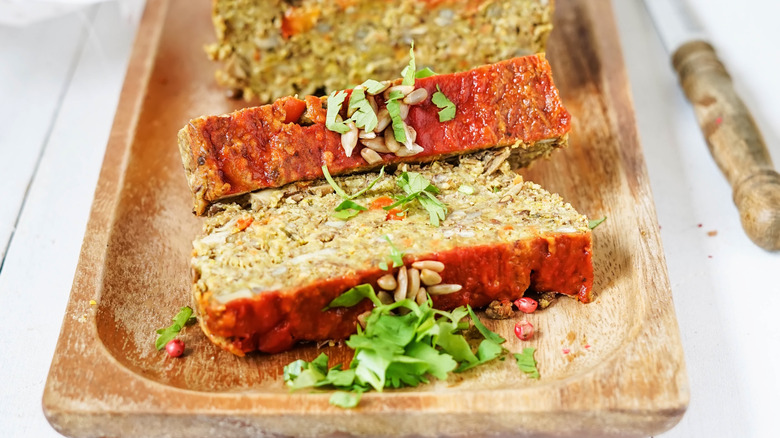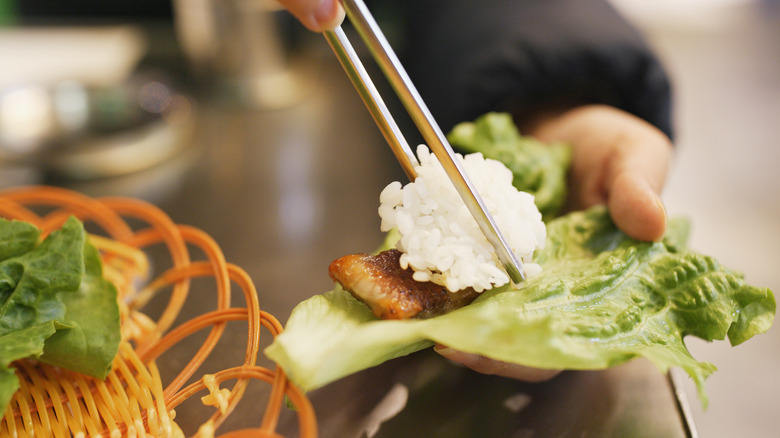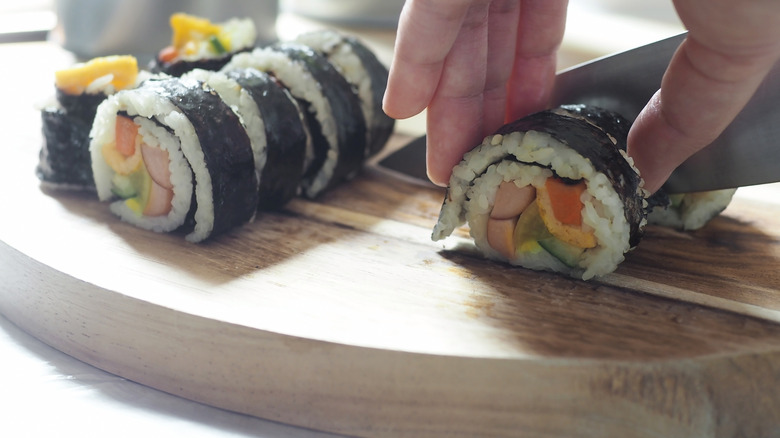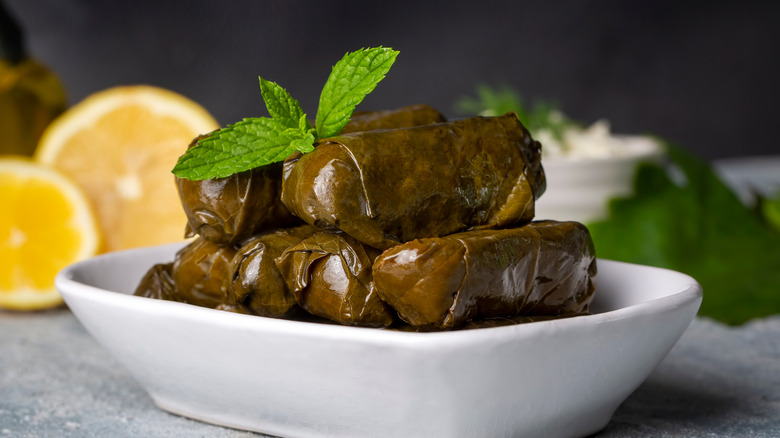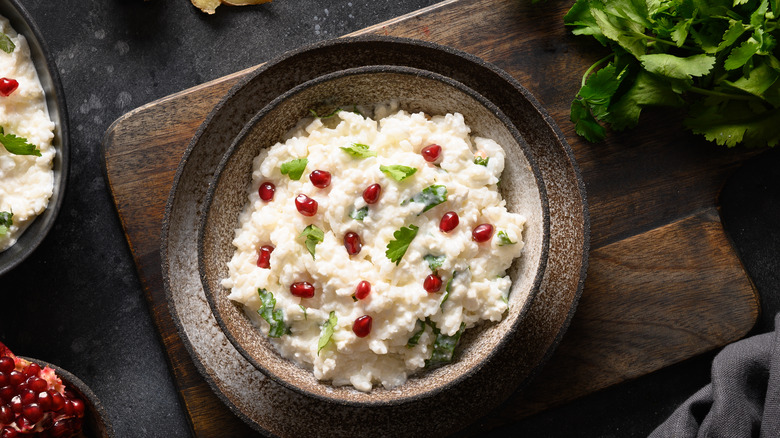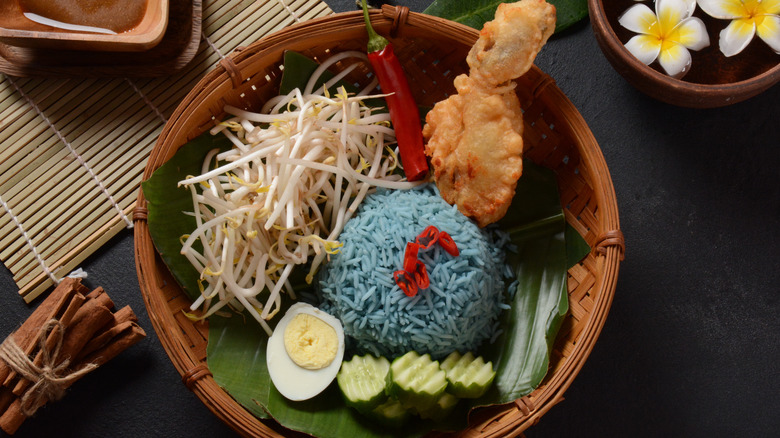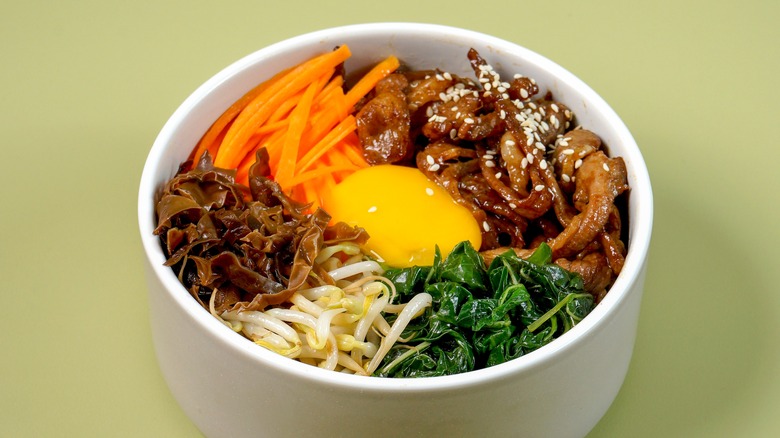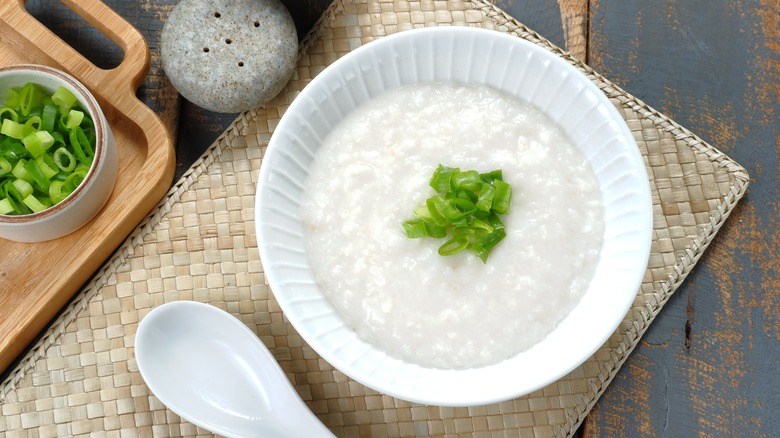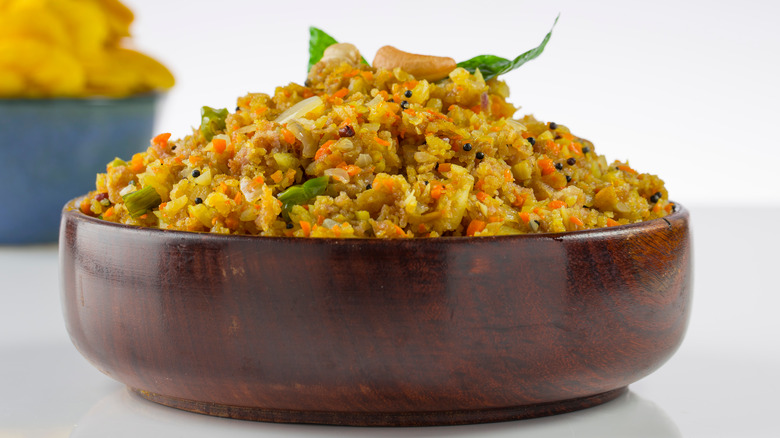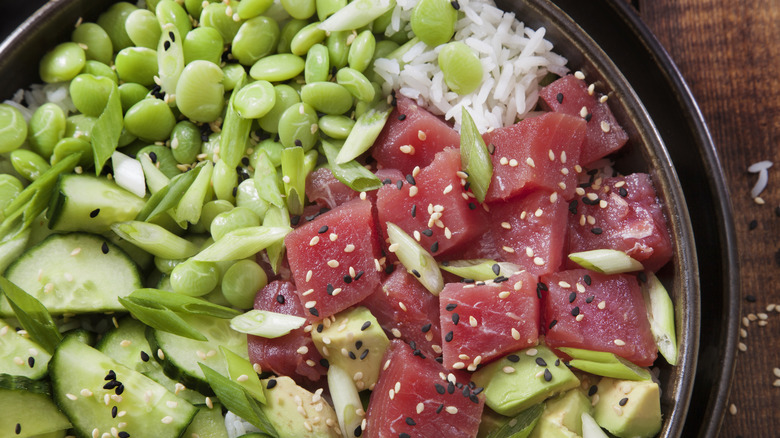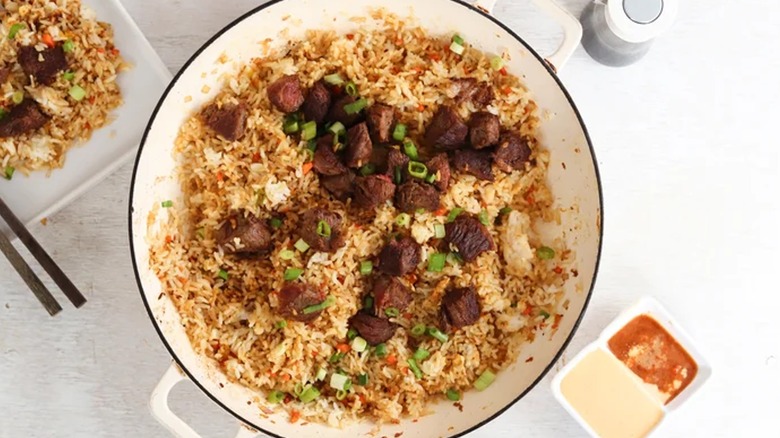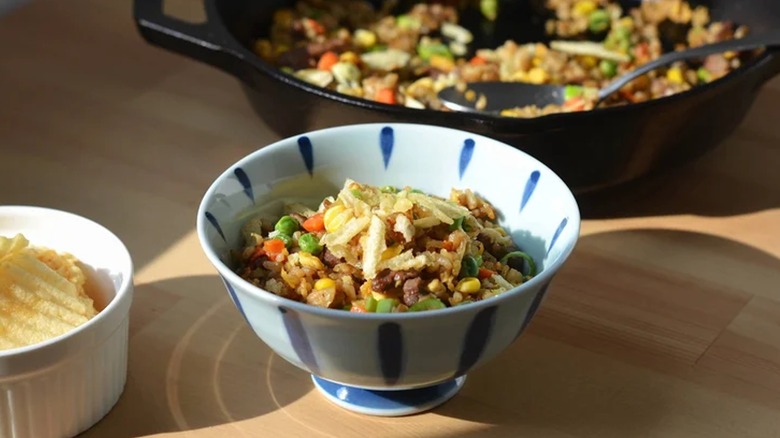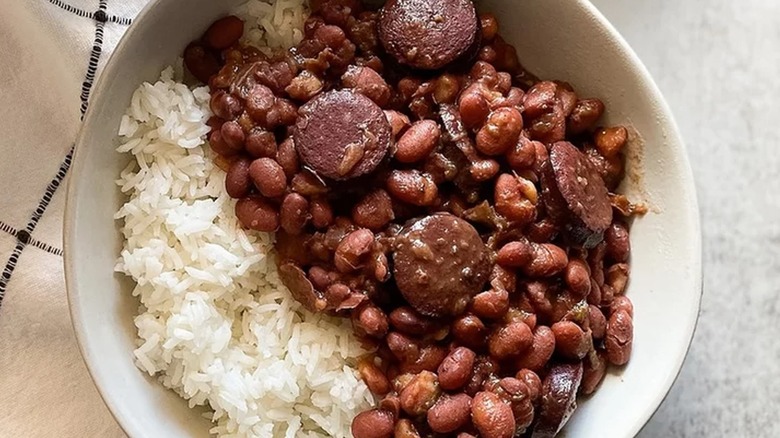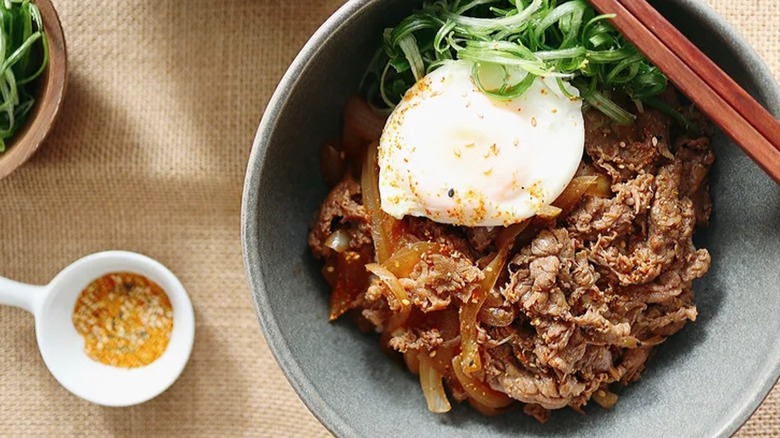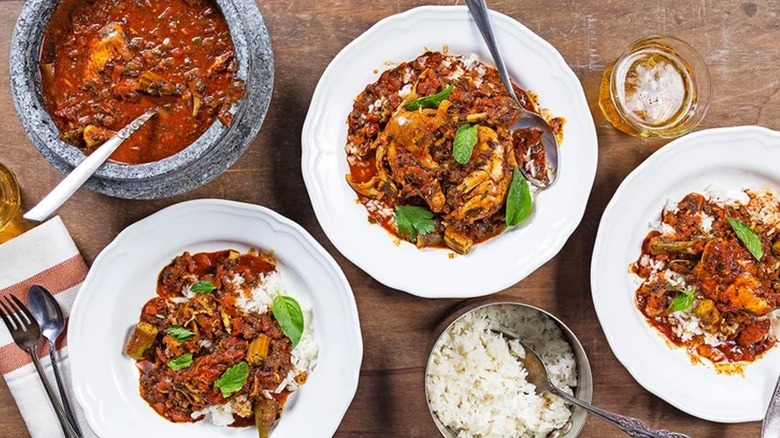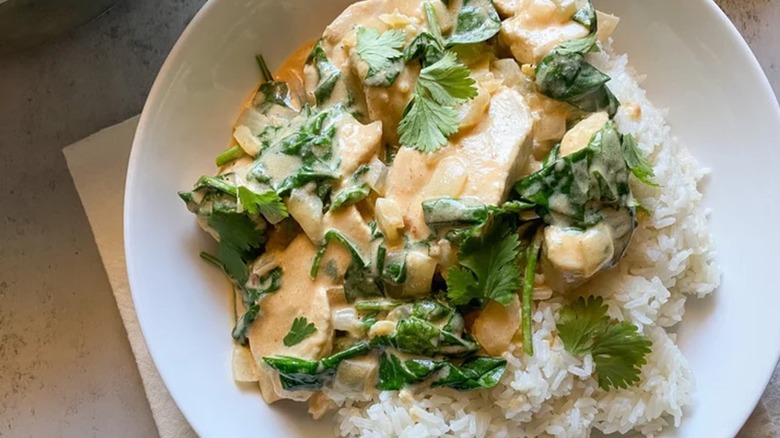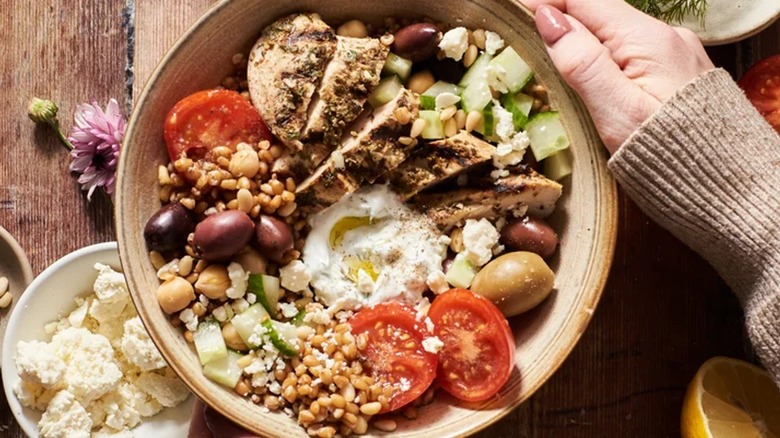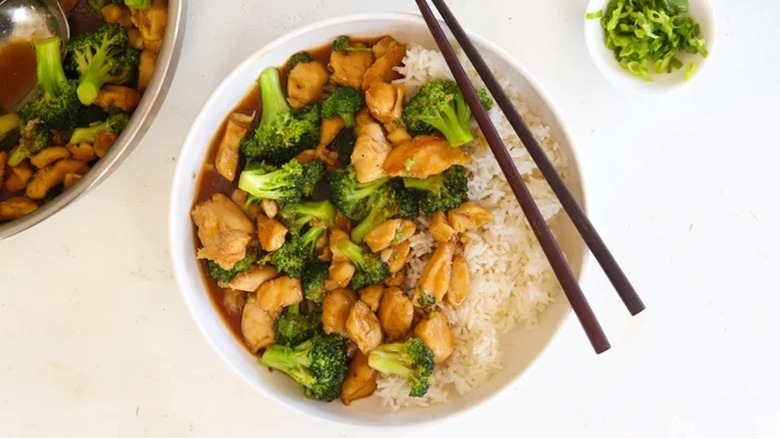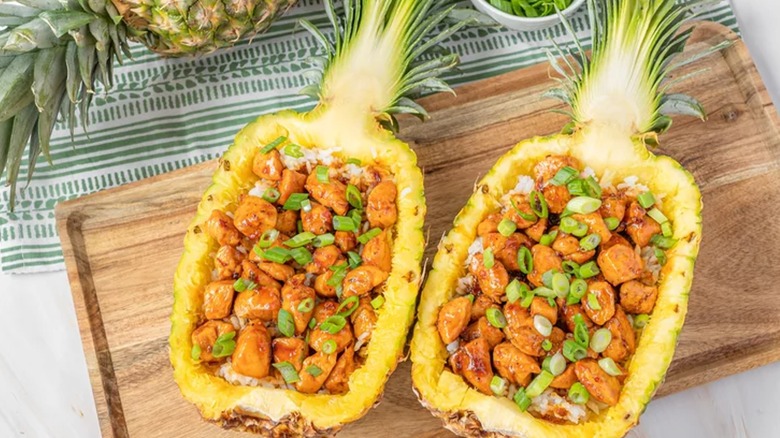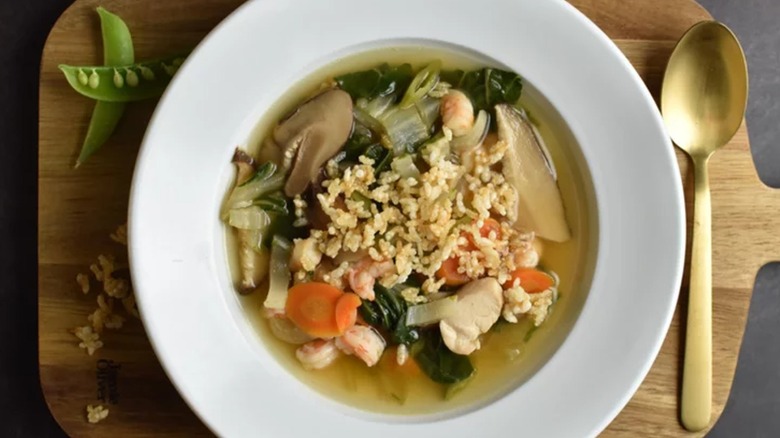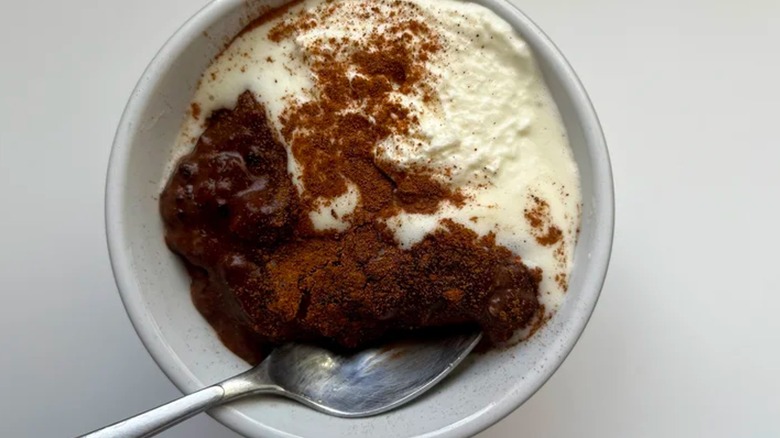36 Delicious Ways To Use Up Leftover Rice
We may receive a commission on purchases made from links.
Every home cook has been here: Dinner is over, and the family has been back for seconds (and thirds), but as you're cleaning up the kitchen you realize you may have prepared more food than intended. No problem, leftovers are always appreciated. What can be more frustrating than having extra food is trying to figure out what to do with it before it spoils. There are some dishes that don't leave room for a second act, instead requiring you to reheat and eat them just as they were originally served. That can get boring. Fortunately, in some lucky situations, your leftover food can take on a new life. Neutral ingredients like pasta, potatoes, or leftover rice can often be reimagined as a totally new food.
Grains have a long post-cooking shelf life, but you shouldn't wait until they become old to get a move on. In the case of rice, there are many ways to turn your leftovers into tomorrow's side dish or main entree. As arguably the most prominent foodstuff in the world, cuisines across the globe use rice in a multitude of delicious ways. The options are endless, but this list will get you started on where to take that pot of rice sitting in your fridge. Most of these ideas are quick to cook and will have you fed in no time. Several are on the adventurous side of the culinary spectrum, and some even offer a sweet treat. Time to get cooking.
Spicy leftover rice recipes
Adding spicy seasonings and sauces to your food can turn a humdrum meal into a flavorful experience, but too much can be overwhelming. Not everyone wants to break into a sweat when they're eating dinner. If you're craving something to eat that packs a punch on the Scoville scale while still wanting to keep your tastebuds intact, you should consider pairing your dish with something neutral, such as leftover rice.
Capsaicin is the molecule that creates the tingling aroma and taste of spicy foods. Typically, the best things to consume if you're trying to cut or complement that burning sensation are oily and fatty foods that can bond with capsaicin. Another option? Starch, such as rice. Leftover rice will have developed a bit more moisture during its time in the fridge which makes it a perfect combination food. Whether it is served alongside stir fry or curry recipes, the starchiness of rice will add a cooling finish to a hot and spicy meal.
Try a few fried rice recipes
There are very few dishes that are made especially better by leftover ingredients, but fried rice is one of them. In fact, many fried rice recipes actually call for grains that are leftover rather than freshly cooked. By giving your rice time to rest in the refrigerator, you are doing your future dinner wonders and getting closer to that special, crave-worthy crispy texture.
Whether you use shrimp, chicken, or just plain veggies, leftover rice is the ticket to perfect homemade fried rice. You'll want to have your rice chilled because if it's warm and just cooked, it releases moisture when you fry it. If you're looking for an inexpensive at-home meal that tastes similar to your favorite Chinese takeout, look no further than the leftover rice in your fridge.
Stir the leftover rice into chicken and rice soup
Whether you're making it from Granny's special family recipe or as a way to clean out the produce crisper, soup is never a bad idea. A hot bowlful will always come in handy when you're hungry, and it is an easy-to-make option for both the new home cook and the seasoned chef. Best of all, soup is incredibly versatile in terms of style and ingredients. There are as many soups as there are people in the world. No matter what type of soup fan you are, there's one thing that most can agree on: A heartier soup means a better soup.
This is where your leftover rice comes in. Need something to warm your stomach and your soul? Chicken and rice soup will do the trick. Looking for something full of bold flavors? Serve a scoop of those day-old grains of rice right into a bowl of steaming chicken and sausage gumbo. In addition to filling out meat-based soups, rice can add protein and substance to your veggie and vegan stylings. Add some rice to almost any soup, your tastebuds will thank you.
Use leftover rice for rice pudding
If a pot of leftover rice doesn't immediately scream "dessert potential," then you may be looking at it wrong. In terms of sweet treats that are easy to make at home, there is one in particular that tops the list and it certainly involves those leftover grains from last night. Rice pudding is a simple snack that makes the most out of your previous cooking efforts without requiring much more.
When it comes to the process of making rice pudding, there are few things that can actually go wrong and most of the ingredients are probably already in your kitchen. A pot of cream, as much (or as little) sugar as you like, a touch of cinnamon, and bon appétit: Your family might think you're on your way to wearing a chef's hat. Plus, your homemade rice pudding is certain to be healthier and less wasteful than plastic single-serve cups from the store.
Use leftover rice to make a creamy risotto
In Italy, there is a saying about where you cook your food. It goes like this, "La cucina piccola fa la casa grande" or, "The small kitchen makes the house big." What it means is that a packed kitchen brings more people together, and more opportunities to cook and spend time with the ones you love. It's a charming saying, but sometimes what a small kitchen really means is limited space for leftovers, such as a pot of rice. In that case, there is more Italian wisdom for you to consider: Cook it into risotto.
Outside of Italy, it's common to find pre-cooked risotto sold among boxed foods like instant mashed potatoes or mac and cheese. Eating risotto like that in Italy might get you banned from the country. All jokes (warnings?) aside, this creamy risotto dish is the perfect way to reuse old rice. Doing so can be a simple, out-of-the-box solution for a quick dinner. Mix your remaining rice with some herbs, stock, and a touch of butter, then serve your risotto as a main dish or a delectable side. Do the Italians proud. You can also kick it up a notch by incorporating lemon and salmon in the risotto.
Fill a burrito
Italian is far from being the only cuisine that has creative uses for leftover rice. Tex-Mex, the Americanized version of Mexican food, offers plenty of suggestions for delicious ways to use up your previously cooked grains. Filling a burrito with rice is perhaps not the most authentic move when it comes to recreating cuisines from south of the border, but it is a crafty, tasty solution for your leftovers.
Try reheating rice by steaming it with some chopped-up cilantro prior to filling your burrito. You'll come out with a burrito base that is similar to what you might order at Chipotle, only without having to pay big bucks for a substantial meal. Using that leftover rice to fill your rolls is what makes a Mission-style burrito, which is the large, hefty kind that will fill you up for a whole day. In vegan burritos, rice will make the perfect complement to beans and veggies. It also can add volume to a scrambled egg and cheese burrito. That's a fast morning meal that won't quickly leave you hungry.
Turn leftover rice into an Italian appetizer
In addition to the simple sophistication of risottos, Italians have other excellent uses for pre-prepped rice, and these dishes are cooked in a way most Americans are very familiar with. Deep-fried rice balls are common street foods in Italy. There are several, distinct styles for cooking these crispy foods but no matter which one you try, your leftover rice will have never tasted so good.
Two of the most common fried rice balls are known as suppli and arancini. Suppli is often found in the narrow alleyways of Rome and is a bit simpler than arancini. It is also smaller. In the center of suppli is a lump of mozzarella, which is then tightly wrapped in a ball of rice. Rolled into flour, and then dumped into oil, suppli is like a Meditteranean version of a mozzarella stick.
For making arancini, the process is similar, but the filling is different. Arancini still has cheese and rice, but it also includes a number of other ingredients, and the components often depend on the cook. From ground meat to prosciutto to vegetables, arancini comes in many styles, and only one flavor: delicious.
Craft some rice cakes
Frying rice is a simple way to reinvent your leftovers, but if you are looking to get a bit more creative, rice cakes are the thing to try. Many cultures utilize the carbohydrate attributes of rice for flour which then becomes bread, crackers, or in some cases, cakes. Rice flour is frequently used in gluten-free baking too. Turning rice into flour is a big process, but there are a few techniques out there that work off of the concept of rice flour without requiring you to have a grain mill at your disposal.
In Indian food, a common use for rice is called idli. This dish is a softly steamed rice cake that typically comes topped with chutney and is served at breakfast time. In-depth, authentic idli recipes call for a bit of experimenting with fermentation, but the results are worthy of the adventure. There are also quick recipes that call for blending pre-cooked rice into a paste that can then be formed into the traditional shape of idli. Making this soft cake will likely take the most effort of any leftover rice recipe, so come to the kitchen prepared to do some work.
Pan-fry crispy rice fritters
South Asian cuisine has more ways to use leftover rice than just cooking it into soft cakes. In fact, there are some regionally common dishes from the area that offer a textural contrast to idli. They also give the crunchy street foods of Italy a run for their money.
Pakora is one particular dish that'll change your rice into something you can sink your teeth into. These crispy fritters are an Indian dish that typically calls for a variety of chopped vegetables to be mixed together with flour before being pan-fried in oil. By combining recipes for pakora with the techniques used for cooking suppli or arancini, you can leverage your leftover rice as a bonding agent, getting a crusty fritter that's dippable and delectable. Season it with the rich and complex Garam spices — such as Rani's Garam Masala — and you'll have a new favorite dinner side dish in no time.
Let leftover rice shine with a few additions
When it comes down to it, rice is the type of ingredient that is comfortable to use. It is a known quantity in the kitchen, but this pedestrian quality actually has a big upside. Because rice is so ordinary, it is easily transformed into the star of another dish.
A great place to start is with mujadara. This dish has origins in Jordan, Palestine, Lebanon, and Syria. Combined with lentils, it is a protein-packed plate that calls for caramelized onions and a large appetite. It can be served hot or chilled. The seasoning combination of cumin and coriander will warm you up however you choose to prepare it.
Another sensational leftover rice recipe is biryani, in addition to mujadara. Biryani is a food that has a diverse history as well as a wide range of ingredients. Featuring everything from potatoes to soaked nuts, to eggs, biryani can be served with meat but is most often vegetarian. What truly distinguishes it from other rice-based dishes is the intricate spices. It is common to add cinnamon, turmeric, black pepper, and/or star anise to plates of biryani. The flavors of this dish are unlike anything else you're likely to make with leftover rice.
Enjoy leftover rice in classic comfort foods
Sometimes what you're really craving is approachable comfort food. In those cases, rice stuffing is a great go-to solution for something homey. Gluten-heavy bread stuffings aren't the only way to cozy up your dinner plate. Fill your favorite produce with a mixture of leftover rice and aromatics (like garlic, shallot, or green onions) for a simple, hearty dish.
When it comes to making rice stuffing, there are a million and one ways you can cook it. To mimic a holiday favorite, mix your rice with diced-up celery and onions, then reheat it with a bit of chicken stock. As holiday foods go, you can also use leftover rice to fill roasted winter squash or pumpkins. In particular, oven-baked acorn squash is made all the better when it's filled with a rice dressing and minced mushrooms. Another internet-favorite? Rice-stuffed bell peppers, which often call for a creamy melted cheese. Fill a Cornish hen, fill some cabbage rolls, and fill your belly with hearty rice stuffing.
Use your leftover rice for paella
Rice is a common subsistence food in many cuisines, but in others, it is often the star of the show. Whether in Spain or Japan, sometimes the perceived quality of seafood depends on the quality of the rice that's supporting it. You may not be cooking up a Michelin Star meal that requires your leftover rice to shine, but there are plenty of dishes out in the world that can be made better by the combination of day-old grains and fresh seafood.
Start with paella. This Spanish meal needs a touch of saffron to be considered traditional. After adding that yellow spice to your leftover rice, you can top it with any seafood you choose and have a fully European meal at a moment's notice. Close your eyes and imagine you're in Valencia. A meaty white fish, mussels, and shrimp are prime pairings.
If you've made a variety of rice that has some sticky qualities to it, why not give homemade sushi a try? The neutral notes of this grain will lend themselves fully to the right piece of tuna or salmon. Don't put your old rice out to sea, give it a new flair with a simple pairing from the ocean.
Bake a rice frittata
By this point in your life, you've probably been made aware that breakfast is an important meal for your day. If you haven't, here is your notice. The benefits of a balanced breakfast are genuine — heart health, energy levels, daily nutritional intake, and even weight management are all things made better and more sustainable by eating a nutritious breakfast. Yet, Americans are hardly making time for this impactful meal. That can be solved by preparing a big batch breakfast that can last all week, and the frittata certainty fits the bill.
The Italian baked egg dish tends to include a mix of veggies, herbs, and cheese, but if you have leftover rice hanging out in the fridge, that works too. If you take inspiration from the French town of Provence — which is just north of Italy — you'll find that it's pretty common to make a version of the frittata with leftover rice. Enjoy a slice cold or give it a quick reheat for a filling morning meal on the go.
Prepare roti
Though there are many dishes that call for rice kernels as a substantial filler, this grain is only ever a few steps away from taking on an entirely different form. Whether you're looking for a unique baking experiment or operating a zero-waste kitchen, the Indian breakfast dish akki roti (or rice roti) is a special way to apply the versatility of your pre-cooked grains. Roti is typically unleavened and made from whole wheat, but this version, which is a staple of Karnataka, can be a good place for you to try substituting some day-old rice as a base for the flatbread.
For example, you can grind white rice up with aromatic ingredients like garlic, ginger, cumin, and chili, then mixed with rice flour as a binder. While a tandoori oven is the traditional way of baking roti, it's more likely that you'll have a tawa or similar non-stick pan handy when it comes time to grill the flatbread. Don't expect roti to get as bubbly as naan bread during this process. Still, with a homemade recipe crafted from recent leftover ingredients, it's a delicious way to start your day.
Use rice in a creamy casserole
One of the easiest ways to give renewed life to that bowl of last night's rice is with a creamy casserole. The options are nearly endless here. Seriously, just Google "rice casseroles," and you'll come upon pages and pages of recipes offering a world of different combinations. Rice and broccoli. Artichoke, rice, and chicken. Rice and peas. Carrots, beef, and rice. A rice and tuna casserole, a stout union of protein and filling starch that you can eat by the scoopful. Each of these zany (or ordinary) fusions between grain and pantry staples can be your solution to an easy dinner on a busy night.
Don't be afraid to get creative either — your family's next favorite meal is yet to be found within those vegetable cans you've got lining your shelves. Regardless of what you're pairing rice with, it's a good bet the dish will benefit when combined with a bit of cream, milk (alternatives, too), and cheese. Casseroles are meant to be comfort food, after all.
Go meatless with a vegetarian grain loaf
Global consumption of beef is on a downward trajectory, and causes for this decade-plus drop are varied. For one, many consumers are beginning to pay close attention to how climate change is affecting the food supply, and specifically, the intensive part that beef production plays in the process. Some hungry eaters have begun to move away from meat as the nutritional benefits of a primarily vegetarian diet become clearer. If you are one of the many individuals opting to go meatless, then the utility of leftover rice as a satisfying substitute is something that will suit your new lifestyle.
Meatloaf has a very specific place in America's weeknight dinner culture, so it's no surprise that vegetarians and vegans developed many techniques to replace the standard ground beef in the comfort food classic. The lentil loaf is a common grain-swapped dish. And best of all, it benefits from the support of pre-cooked rice. If you find yourself with extra grains on hand, consider baking them into this hardy form, adding a tangy tomato sauce to keep things moist and flavorful. Serve slices of your grain loaf with piping hot Southern sides, or make a toasted melt sandwich.
Scoop leftover rice into lettuce wraps
If you're looking to cut down on the carbs, consider a crisp lettuce wrap. Options are endless, with fillings covering everything from meats and vegetables to cheese and nuts. Adding leftover rice to the mix will buff out your wrap even more while helping to cut down food waste, not to mention the cost of your meal. (The kernels would certainly be a fine addition to our ground pork lettuce wraps recipe.)
One of the best things about lettuce wraps (besides the colorful produce), is the range of sauces that tend to accompany them. The inclusion of rice only adds to the allure of giving your wrap a dunk in a flavor bath. Think of sushi: Pouring salty dressings over clean, cold rice is a distinct pleasure. But whether saline soy or sweet and spicy — rice complements the entire range of tastes, especially when folded between lush leaves of lettuce.
Get rolling with kimbap
The popular Korean rice roll kimbap may look similar in appearance to Japanese sushi, but the similarities end there. Kimbap rice is dressed with the toasted nuttiness of sesame oil, while sushi rice which gets a clean tang of a vinegar seasoning. The sauces and complementing ingredients are different too — look out for different types of kimchi in place of soy sauce or wasabi.
Another key difference is the fillings. Rather than going raw, cooked ingredients are standard for kimbap, and you can regularly make or discover rolls with additions like ham, cheese, egg, radishes, and even Spam. Korean BBQ favorites like beef bulgogi are also a hot way to turn your leftovers into a succulent new dinner. Don't forget the nori to wrap everything up. While fresh rice is preferable, your leftovers will work too. To help soften those grains, simply follow the advice of Foodie Baker and pan fry your kimbap after giving the roll a dip in beaten egg.
Stuff rice into dolmas
In Azerbaijan, dolma-making is considered a beacon of cultural identity, and the dish has a storied history. When you start using your leftover rice to create this influential food on the regular, it may become part of your kitchen's identity as well. The reasons are simple: Dolmas are convenient, easy, and delicious. These are all things that you need to make the most of your day-old grains. Hopefully, the only clash is over who gets to eat the last one.
There shouldn't be any fight, however: Preparation for dolmas couldn't be more convenient. The majority of the cooking time for the finger food comes down to boiling the rice — but you'll already have that covered. Then, all you need are pickled vine leaves (grape leaves are the most common wrapper) and various spices, onions, and garlic. With a quick reheating of that cold bowl in the back of the fridge, finished with a squirt of lemon, you can take your taste buds on an exploration of international food politics and history.
Go sweet or savory with curd rice
If you're not already making it, curd rice should rank near the top in your personal home-cooking category of easiest things to do with leftover rice. The dish is big in South Indian cuisine and goes by several names and forms. Each variation carries with it the potential to morph from a plain base to a seasoned sensation.
So, what is curd rice? It's a simple combination of cooked rice and plain yogurt. While one can find curd rice served with mango pieces or pomegranate seeds, the flavors of curd rice are normally savory. Minced green chilis, carrots, curry powder, cumin seeds, and even ketchup are among the ingredients you can add. If rice, probiotic yogurt, and a dash of Heinz 57 doesn't work for you, don't stress. When using your leftover rice for this dish, you get to decide what flavors to pair.
Kick up the heat with nasi ulam
Indian cuisines offer many ways to use up your pre-cooked rice, but India is far from being the only country in the world where day-old grains play a crucial ingredient. To find your next inspiring meal made from leftovers, continue following the map eastward until you land in Malaysia. Here, a traditional dish called nasi ulam will provide you will an excellent outlet for using leftover rice. In fact, this dish requires cold grains, so there are few plates as perfectly suited to meet your cooking needs.
Nasi ulam has spread throughout many Southeast Asian cuisines, as delicious food is known to do. Considering there are different versions of the dish, it has the potential to take on many different flavors or profiles. As mentioned, nasi ulam is commonly served cold, but it is accompanied by diced and minced ingredients, which can be added to the rice cold or hot. Popular accompaniments range from basil, lemongrass, and kaffir lime leaves, to hearty pieces of flaked fish or chopped shrimp. One thing that can't be forgotten is the sambal; this spicy chili paste — such as Homiah's Sambal Chili Crunch — is a must-have dressing for your cold rice salad. If you want to repurpose your rice into a dish with multiple layers of flavor, look no further than nasi ulam.
Put together a batch of bibimbap
In Korean, the word for rice is bap, and bibim means mixing, which translates the literal name for bibimbap as mixed rice. For this reason, as well as a few others, it's the perfect use for leftover rice. Bibimbap is easy to make and can be an incredibly nutritious method for reheating last night's leftovers. It consists of a number of vegetables, usually meat, and often an egg served over cooked rice and mixed with sauce. Having a pot of pre-cooked grains takes the work out of half the dish.
For an exciting nutrient-packed meal, consider following a vegetarian bibimbap recipe. Along with the unctuous and umami layers of soy sauce and gochujang that go into the dish, a veggie bibimbap brings snappy bean sprouts, earthy mushrooms, and the textural crunch of cabbage to a bowl of rice. After sauteing the vegetables and frying an egg, there's little else to do — especially when your rice is already cooked — but mix the ingredients together and eat. The whole dish can come together in as little as 24 minutes.
Cook congee with leftover rice
Congee is an essential dish for many cuisines across the globe, particularly so in East and Southeast Asian countries. It uses a watery method for cooking rice; with congee, the grains are cooked in a large volume of liquid leading to an end result that's a bit starchy and closer to porridge. This makes it great for topping with additional ingredients — eggs, ground meat, or green onions, for example — but the thickness and simplicity make classic congee light, easy on the stomach, and easy to modify.
When using leftover rice for congee, you'll have to make some adjustments, since the key part of this dish is how it was cooked in the first place. You'll need to reheat your grains in a pot of hot water or stock, essentially looking for a ratio that's less brothy than soup. Avoid restarting the cooking and absorption process by getting the liquid hot before you put the rice in, and then quickly break up any clumped grains as it all warms together. Once the mixture is hot, top with minced pork and garlic, kimchi, or heaps of green onion and fresh herbs. Your leftover rice will have new life as a nourishing comfort food.
Try some breakfast rice recipes
If you're used to Western cuisines, then it's natural to think of breakfast as having sweet potential: pancakes, sfogliatelle, French toast, or pain au chocolat. Even Greek yogurt is regularly topped with granola, honey, and an array of fruit. For much of the world though, breakfast is a savory affair, which is an exciting proposition when you consider how many uses for leftover rice that opens up.
A breakfast bowl of leftover rice needs to be on your radar. For example, in this coconut rice bowl, you can bring together bok choy, cilantro, lime, and ginger for a fragrant and slightly peppery flavor combination. Then toss in some coconut oil and pre-cooked rice, and you'll have a unique and flavorful morning meal ready in under 35 minutes.
Another way that rice is eaten for breakfast across the world is in kanda poha recipes that hail from Maharashtra, India. The traditional breakfast meal has a mix of fried peanuts, onion, and ginger that combine with an aromatic range of spices: chili powder, cumin, curry powder, coriander, mustard seeds, and turmeric. Although it calls for a specific type of flattened rice called poha, you can shortcut the preparation by adding in leftover grains near the end of the typical recipe. Leftover rice works particularly well as poha should never be mushy when combined with the other components of the dish, and chances are, your dinner grains from yesterday's meal will have dried a bit in the fridge overnight.
Assemble a poke bowl with leftover rice
Poke bowls are, hands down, one of the easiest ways to use leftover rice because they don't even involve reheating it. Instead, the harder part is locating fish fresh enough to serve raw overtop your homemade bowl of grains. With that in mind, the beauty of poke is that you can top it with a wide range of components, so if chicken katsu or cooked salmon is more accessible than ahi tuna, nobody here can tell you that you're wrong.
For this leftover rice dish, try following a classic California roll bowl recipe. You can rehydrate the rice with a touch of rice vinegar (which also helps ignite the sticky texture) and double down on making the grains luscious again by topping them with spicy mayo. Throw on some cucumber, avocado, nori, and a couple of hunks of imitation crab, and you've saved yourself $15 at Pokeworks all while reducing the food waste from your own kitchen.
Whip up some hibachi-style steak fried rice
Because rice loses moisture as it hangs out in the fridge, one of the best techniques for this grain as a leftover is to fry it. Rice won't fry as well when it's freshly cooked because it's still wet, which results in a somewhat steam-like cook rather than the crisp, crunchy edges that a good fried rice is known for. So, pulling out last night's remains sets you up perfectly for this hibachi-style fried rice with grilled steak.
This recipe calls for a leaner cut of steak, like sirloin or New York strip, but the pre-cooked leftover rice is what really gives you the feeling of sitting at a hibachi table watching the chef make volcanoes out of rings of raw onion. If you're working with leftover steak as well, the recipe can come together in as little as 10 minutes, the most time-consuming part of the process being found in sweating out alliums and carrots. Top with some yum-yum sauce, and you're likely to forget that the rice was ever leftover to begin with.
Try potato chip beef fried rice
When rice is left alone in the fridge for a day (or two), the starch it contains undergoes a process called retrogradation. It's a scientific term that implies a lot of chemistry facts you don't necessarily need to know, but what is important to understand is that the starch develops a crystalline structure, which, in turn, firms the texture of the grain and readies it for another round of cooking. It's the other key reason why leftover rice is great for frying. If crunch is what you're looking for from last night's carb, wait until you try potato chip fried rice.
For this leftover rice recipe, you'll start by using your grains to make a familiar bowl of fried rice, complete with eggs, a veggie mix, scallions, flank steak, and a sauce mix of oyster and soy combined. After scrambling the eggs, grilling the steak, and crisping your rice and produce, add a healthy crush of potato chips over the top as a garnish. Although the recipe calls for standard, salted potato chips, you can take the dish in a unique direction with barbecue, sour cream and onion, or even salt and vinegar chips.
Make New Orleans red beans and rice
New Orleans cuisine offers a lot of opportunities to put leftover rice to good use: You can serve it over gumbo, make dirty rice, or try one of the region's most special signature dishes: New Orleans red beans and rice. Few dishes are as comforting on a chilly day as a pot of cooked beans and andouille sausage seasoned heavily and accompanied by onions and peppers. A scoop of rice on top makes your day-old grain the belle of the ball, which is a very NOLA thing in and of itself. In this city, everyone can be a star.
Not only is red beans and rice a spicy way to bring new life to leftover rice, but it also goes with the history of the dish. Slow-cooked beans are rooted in the many African culinary traditions that found a home in New Orleans; later, during the Great Depression, red beans and rice as a specific dish earned a place as a city staple for its "nothing goes to waste" reputation. So, while the starchy feel of leftover rice is a good gastronomic pairing, it's also fitting on a cultural level, too.
Scoop leftover rice into a gyudon bowl
For a sweet, savory, and salty take on your leftover rice, consider using it in a recipe for gyudon, a type of Japanese rice bowl with shredded beef. Unlike a fried rice recipe that requires you to recook your rice, you can use last night's grains without any additional preparation — a simple zap in the microwave or warm-up over the stove will do. With the rice already cooked, you can have dinner on the table in less than 15 minutes.
You'll need about 2 cups of cooked white rice for the recipe, but don't worry if you're a bit short. The grains are topped with a mixture of beef and onions that are simmered in a sauce made of mirin, sake, soy sauce, sugar, and dashi, which give the bowl a multilayered taste that's both full of umami and features a sweet, acidic touch. Ground it all with a garnish of toasted sesame seeds.
Use your leftover rice in Brazilian chicken stew
The beauty of a good Brazilian chicken stew recipe isn't in the ability to make it quickly. Instead, it's the opposite. Creating a quality stew requires time and lots of layered ingredients that build on top of one another. That said, the flavors are warming and fierce — just the sort of recipe you need when the season starts to change. You can butcher your own whole chicken or buy pre-cut pieces which you'll then stew with a garden of herbs: parsley, cilantro, basil, and mint. The body of the stew is also bulked up with onions, jalapeño, and okra, balanced by white vinegar, and thickened with tapioca.
Where does your leftover rice come in? Although this recipe does call for rice that's been toasted before it's cooked, you'll have to skip that step by virtue of having rice that's already prepared. However, you won't want to miss the opportunity to sweat out some white or yellow onions, which you'll then combine with your rice for a sharp, pungent taste. Pour the stew over your revived grains, and bom proveito.
Thai red curry is a great leftover rice recipe
Some international cuisines lend themselves better to using up leftover rice than others. Thailand's agricultural systems thrive on rice; it's one of the top countries in the world in terms of the amount of land under rice production. Needless to say, you'll find an abundance of Thai recipes that lend to making old cooked grains new. One of the most approachable is using your leftover rice for a Thai red curry with chicken.
Of course, the beauty of this recipe as it relates to rice is that no special preparation is needed. Simply heat your grains (once your curry is cooked) and plop a scoop on top of the curry. The sauce — which is made from coconut milk, garlic, ginger, onion, coriander, and red curry paste like the kind from Thai Kitchen — offers big flavor for little effort. The spicier you make your curry, the more important the cooling taste of cooked rice becomes.
Cook up Greek-inspired chicken and rice
Unlike Thailand, Greece isn't necessarily known for being a nation of rice growers. That said, the flavors of this island country go great with leftover rice, especially if it's a brown or wild variety that you have chilled in the fridge from a few meals past. The heartier profiles of these rice varieties go especially well when stacked against the briny flavors of Greek cuisine, but if white rice is what you've got on hand, that will still go just as well.
Try this recipe for a grilled Greek chicken grain bowl. Start with chicken that's marinated in a sweet and citrusy blend of lemon, honey, thyme, oregano, parsley, and olive oil. As you're letting that chicken rest and soak up some flavor, you can build a tzatziki sauce to top your bowl and prep the vegetable components — tomatoes, olives, cucumber, and garbanzo beans are all great additions. Add a bit of salty feta and the forest flavor of pine nuts, and you'll certainly feel like setting sail to Mykonos. What's best about this recipe is that, along with the leftover rice, you likely have most ingredients already stocked in your pantry.
Use leftover rice in soy chicken and broccoli
Having leftover rice on hand is a windfall on those days when you're craving takeout but know that it's better for the budget if you eat whatever is in the fridge. We all have those moments, and when we reach them, turning last night's dinner into a tried-and-true version of a classic Chinese-American takeout meal is the move. One example is a play on beef and broccoli, wherein the bovine is swapped for poultry but the rice base remains the same.
Consider using your leftover rice for a velvety soy chicken and broccoli dish that hits all the right dinner notes, including requiring minimal effort in the kitchen. You'll marinate your protein in a mix of baking soda, sherry, and soy sauce, steaming the broccoli as it soaks. Then, you'll brown the meat, add the veg, and combine with a succulent sauce of garlic, ginger, pepper, soy, and oyster sauce. It's bodied with cornstarch and lays silky smooth overtop of that container of leftover rice that you (previously) didn't have any plans for.
Scoop some rice into pineapple chicken boats
Rice serves a great role as a filler, such as in this pineapple teriyaki chicken boat recipe. You can use essentially any type of leftover rice here, with the neutral but slightly nutty flavor of the grain providing a balancing contrast to the tropical sugar of pineapple and woody sweetness of teriyaki. Although this recipe calls for an entire cup per half of pineapple, a little less will leave room for more protein in your boat.
To sail this dish to the dinner table, start by slicing a pineapple in half, and then carve it clean by cross-hatching the fruit and scooping out the pieces. After that, you'll marinate your skinless chicken tenderloin in a homemade teriyaki sauce (or hop a few steps forward by using your favorite pre-bottled brand). Once the chicken has been cooked and the sauce is reduced, say aloha to your leftover rice by reheating it using whatever method you prefer. Layer it in your boats, and top with the chicken.
Make sizzling rice soup
It's a simple fact of life that no category of food is better suited for using up a ton of leftovers than soup. This includes rice, as our sizzling rice soup recipe goes to show. Like fried rice, it's a recipe that requires having pre-cooked grains on hand and is intended to use leftovers. It also works in chicken, shrimp, mushrooms, bok choy, and carrots. This soup is dense with delicious goods, with the rice playing the part of inventive garnish.
The cool thing about this recipe is that it involves re-cooking your leftover rice not once, but twice: First, you bake it in the oven, which serves the dual purpose of warming and drying it. Then, you essentially deep-fry it until it's brittle and toasted. Once the rice has become crisp, you drop it in the soup. This creates a fun, sizzling effect that's sure to get the attention of any hungry eaters at home. Best of all, since the rice isn't making up the full body of the soup, you don't need to have an exceptionally large amount to make this recipe.
Stir up some arroz con leche with Mexican-inspired hot chocolate
Arroz con leche, or rice with milk, is a rice pudding dessert often associated with Mexico and Peru. In fact, the dish arrived in Latin America through Spanish colonization, with the Spanish having learned of the dish from Muslim countries which invaded in the year 711. All of that is to say, it's a well-traveled sweet that has variations worldwide. One of our favorites might be this Mexican hot chocolate arroz con leche rendition, which, as a use for leftover rice, is a treat.
Because rice pudding is delicious when consumed both hot or cold, you can actually make the pudding part separately and then work in your leftover rice straight from the fridge after it has cooled. If you want to eat this dessert hot, we recommend cutting down the cooking time so you don't overcook the premade grains and end up ruining the desired texture. A little bit of chili, cinnamon, and cayenne give this dessert a symphony of spicy notes different from any final course you might follow up your main meal with.
